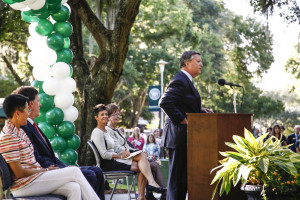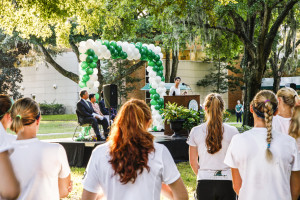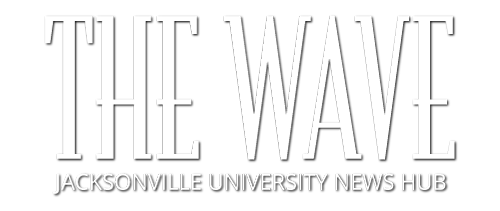The numbers tell a dynamic story about the College of Health Sciences’ new state-of-the-art building: 30,000 square feet of high-tech equipment and learning space, a fast-climbing enrollment currently at 1,900 students, and more than $6.5 million invested by the University and its 300-plus health care community partners, all to preserve and expand outcomes like 2014’s 97% nursing license exam pass rate.
But the story doesn’t stop there. It’s also about people.
Over its rich three-decade history, the College of Health Sciences, which began as the School of Nursing, has become known in the region for its caring faculty, dedicated students and visionary leaders.
All of that and more was celebrated in grand style Thursday, Sept. 4, during a ribbon-cutting ceremony that drew hundreds of supporters and the campus community, who toured the new center and were wowed by demonstrations of medical equipment and activities scattered throughout the building.
“Today we celebrate not only the opening of a state-of-the-art health sciences education building, but also the vibrant environment and renewed commitment toward academic excellence exploding on our campus,” JU President Tim Cost told those gathered, including representatives from health partners such as Baptist Health, Brooks Rehabilitation, The Mayo Clinic, St. Vincent’s, UF Health and Memorial Hospital
The new facility cements the College of Health Sciences’ reputation as the leading health care educator in the region, providing the most prepared graduates ready to meet employer needs in a fast-changing health field.
 Among its many amenities, it includes dedicated, reconfigurable and multipurpose learning environments; event space and meeting rooms; a state-of-the-art Simulation Training and Applied Research (STAR) Center with 14 beds of newborn to adult patient mannequins; and an Advanced Novel Equipment Workspace (NEW) speech pathology lab and Physically Active Lifestyles (PAL) lab.
Among its many amenities, it includes dedicated, reconfigurable and multipurpose learning environments; event space and meeting rooms; a state-of-the-art Simulation Training and Applied Research (STAR) Center with 14 beds of newborn to adult patient mannequins; and an Advanced Novel Equipment Workspace (NEW) speech pathology lab and Physically Active Lifestyles (PAL) lab.
“I am fortunate to have been chosen to lead such a phenomenal group of faculty and students,” said new College of Health Sciences Dean Dr. Christine Sapienza, a national leader in speech-language pathology. “At JU, we are unrestricted by old models of training. The dynamics of health care is receiving increasing attention, from emergency room costs to the burden of health care disparities in access and outcome. We intend to be positioned to discuss these controversies and the opportunities of these issues.”
Doug Baer, CEO of JU speech pathology partner Brooks Rehabilitation, praised the University for its bold leadership and approach to collaboration with the health care community.
“There is so much energy here that it’s infectious,” he said. “Christine’s passion is going to elevate speech pathology services in the region. What’s happening is transformational, and the community has embraced what’s going on here. It’s only natural for Brooks Rehabilitation to support it. This is only the beginning.”
Ultimately, beyond the bricks, technology and equipment, it’s people like 25-year-old Anna Farrell, working toward her Master of Science in Speech Language Pathology, who bolster the College of Health Sciences’ reputation for producing critical-thinking health care professionals who act with compassion.
“I am so proud to be a student here,” said Farrell, marveling at the new building. “We are able to practice things here that you can’t at other schools, like performing endoscopies on the mannequins. We have the best faculty who give hands-on guidance. I know I’m going to be well-prepared when I go into the job market.”
Baptist Health Senior Vice President Diane Raines walked the crowd through JU’s pioneering activities in health care education as it continues to produce excellent graduates.
“You have been early adopters, from your masters programs, to online education, to nurse practitioner training, to accelerated RN programs … to being a leader in developing patient safety education standards,” she said. “JU nurses are sought after by employers because of who they are and what they know. They are making contributions here and across the country … especially because of the focus on interdisciplinary training and modeling the best aspects of human caring that are critical to health care.”
 Wave Magazine Online Jacksonville University News Hub
Wave Magazine Online Jacksonville University News Hub
